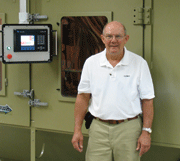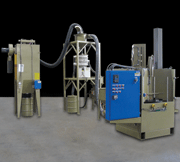E-Archive
Interview
in Vol. 9 - September Issue - Year 2008
One Versatile Company with More than Fifty Years of Experience Demonstrates Sophisticated Shot Peening Expertise

Herb Tobben, Sample Processing Manager, in the lab standing alongside his new state-of-the-art multi-functional automated blast-process simulator.

This pressure-blast automated glass bead peening system includes precision indexing, and PLC-controlled vertical positioning, oscillating and rotation of two side-angle nozzles for small bore ID peening.

This pressure-blast steel shot peening machine featured a computerized teach-and-repeat system to permit the customer to easily process a variety of parts in a single automated machine, reducing costly set up time.
The American company, Clemco Industries Corp., based in Washington, MO USA, has been designing and building standard and specialized blast and shot peening equipment for industry for more than five decades. Today Clemco equipment can incorporate time-saving, labor-saving, money-saving, ergonomic, and operator safety features to help customers operate as safely, productively, and efficiently as possible. ZERO blast cabinets are in use throughout the world. Interview with Herb Tobben, Sample Processing Manager, Technical Services Department, Clemco Industries Corp.
(?) MFN: How did your company become involved in shot peening?
(!) H.T.: Starting in the 1940s, ZERO Manufacturing Company, fabricated stainless steel milk handling equipment for the dairy industry, sold initially in the USA, and later in Europe, and Asia. To reduce labor associated with grinding, improve appearance, and produce a food-grade finish on its products, ZERO fabricated its own blast cabinet in the 1950s. Soon after, making blast cabinets became a good business. Listening to customers and responding to their needs drew us further into blasting and into shot peening. We have continued to follow that strategy and design machines to suit customers’ specific requirements rather than apply a common solution to all shot peening applications.
(?) MFN: How did you develop this expertise?
(!) H.T.: Our approach from the very beginning was to work closely with our customer and design a machine to solve a particular problem. We created a processing laboratory and outfitted it with a variety of machines for pressure blasting, suction blasting, and with different means to manipulate nozzles and move parts through the blast cabinet, such as belts, monorails, work cars turntables, etc. We made cabinets of different sizes to accommodate the needs of different industries. In the early 1960s, our first shot peening clients were automotive and aviation customers, who had a need for shot peening to improve fatigue life and reduce stress corrosion cracking. We have since devoted many years evaluating applications, applying our experience, and developing new methods to help customers make improve their products.
(?) MFN: More than forty years in shot peening is quite an achievement and implies a very successful business. Can you elaborate on some of your shot peening systems?
(!) H.T.: We have worked on many very interesting projects, of varying levels of sophistication, most of which involve cabinets. By sophistication, I mean the complexity of controls, degree of automation, and part handling technology.
One project, for example, was for an automotive OEM supplier, who was looking to make their fuel injector nozzles more durable. They were having a problem with the tips of their injector nozzles breaking and cracking, causing the loss of engines. Our sample processing determined that shot peening the tips eliminated nozzle failures. The customer’s production rate was 60 parts per hour. They had hoped to increase that rate to 600 parts per hour with our automated system. To meet that requirement, we incorporated a pick-and-place robot. Parts traveled through the precision-indexing system and performed to tolerances of a few thousandths of an inch. Each satellite carried a magnetic fixture for both holding and masking the part. The system worked so well for the customer that they surpassed their goal by more than 50%, achieving more than 900 parts per hour. In addition, their in-house destructive testing demonstrated a doubling of the fatigue life of the part.
Another involved steam turbines and the need to shot peen the root section of turbine blades. These blades had exceptionally large root sections. They came in a variety of sizes and shapes. The customer was very concerned about maintaining peening intensity within a narrow range for every part. We designed a special size pressure-blast indexing-turntable cabinet fabricated of ¼-inch steel plate. The blast machine was equipped with eight shot flow controllers to feed eight nozzles, some fixed, and some with 24-inch stroke oscillating arms. Special fixtures for the variety of parts virtually eliminated changeover downtime.
Others include a ‘walking beam’ conveyor machine for shot peening heavy vehicle torsion bars. Multiple torsion bars were loaded on the walking beam conveyor outside the blast chamber. The parts automatically indexed through the system and each part was placed on a set of horizontal part rotation rollers inside the blast chamber to expose all areas of the part for shot peening. The bars required differing peening intensities on the center and spline ends. Multiple individually controlled air blast nozzles mounted on an oscillation device provided the ability to meet that requirement.
For a commercial aircraft engine rebuild facility, we designed a pair of large, door-mounted-turntable shot peening systems that would allow the customer to load and process a complete set of fan blades for shot peening. To comply with the strict specifications governing engine rebuilding, re-verification of shot peening intensity and saturation with almen strips are required a minimum of every eight hours of operation or whenever there was a part or process parameter change. One system we provided handled glass bead for shot peening the airfoil section, and the other steel shot for peening the root sections.
We designed a machine for another engine rebuilder for shot peening various jet engine parts. Our system included one nozzle for peening the OD of the part and one with a rotating lance nozzle for hole or slot peening. This versatile machine had horizontal and vertical traverse mechanisms, and pneumatic shot recovery with vibratory shot classification.
(?) MFN: You mentioned earlier that you design machines of varying levels of sophistication. Can you tell us more about that?
(!) H.T.: First, we evaluate the customer’s application, including part type and desired production rate. Next, we establish the pertinent specification that applies to the application. Once all parameters are established, we design a system to do the job. The level of sophistication depends upon many factors, perhaps most importantly, the shot peening specification. Stringent shot peening specifications demand numerous controls and monitors, so that the process is precise and documentable Equipment such as computerized numerical controls (CNC) or programmable logic controllers (PLC) or shot flow controls, closed-loop air pressure control, shot level sensors. With our highly efficient media reclaimer systems, we can incorporate classification equipment, such as vibratory for controlling shot size and spiral for controlling shape, discarding broken or out-of-round media. For accommodating several intensity requirements simultaneously, we provide controls for individual nozzles. We have built numerous systems for our larger customers with these sophisticated, integrated components. Our engineers and technicians have received the necessary training to operate, program, and service this equipment. More and more frequently, our customers with high production demand for accurate, repeatable processing are interested in these types of options on their production systems.
(?) MFN: What would you say is your most unusual peening machine solution?
(!) H.T.: Several years ago, we were approached by the US Air Force to evaluate their need to shot peen the inside diameter of landing gear components. Landing gear suffers enormous stress from the weight of heavily laden planes and repeated landings. During scheduled maintenance or after an especially rough landing, maintenance personnel disassemble critical components and shot peen them before reassembly to the aircraft. In this case, the USAF customer wanted to do the peening without removing the part from the plane to save time. The part to be shot peened was located almost ten feet above the ground! To accommodate this unusual situation, we combined several technologies to solve the problem. In fact, this system included a Baiker nozzle with a controller to control rotation speed. The machine was fitted with other controls to control blast duration and nozzle oscillation. All the components were attached to a modified ZERO SuperComet, which is a portable, closed-circuit pressure blast system. We added a telescoping arm to reach the target, which was an area that measured 15 inches in diameter and four inches deep. This special assembly of equipment ensured precise, repeatable peening. While this may have been a somewhat awkward environment for shot peening, our creative solution saved a great deal of time for the customer, who was delighted that they could eliminate the removal and reinstallation of the part. In fact, the system is so useful to the USAF, they have since ordered a second system for another maintenance and repair base.
(?) MFN: Clemco has been involved in shot peening now for so many years, I’m curious about what trends or changes you observe in the sector?
(!) H.T.: The first applications of shot peening were in the automotive sector, therefore, we first dealt with parts such as springs, gears, shafts, and connecting rods. Later, we began working with aircraft and aircraft engine parts and other aerospace components. Today we see applications across many industries, including power generation, petrochemical and medical. Advances in medical technology , particularly in the area of body implants has expanded the application of shot peening for items such as implant screws, and smaller and smaller components.
As far as specifications go, we are seeing a steady trend toward more control requirements and guaranteed repeatability. Manual shot peening is disappearing as automated systems ensure precise repeatability. While originally the US military developed and maintained the specifications most customers followed, today the Aerospace Material Specification (AMS) is administered by the SAE International. The changes in the industry specifications for shot peening, are all going in the direction of more precise control and narrower ranges of peening intensities and other critical aspects. Computer monitoring equipment is required for monitoring and controlling shot flow, media mix, peening time, air pressure etc.
The reasons for the changes are numerous: safety, performance, liability among them. As the world becomes increasingly safety oriented; so too are we; and we are constantly incorporating more operator-safety, ergonomic, and productivity tools into the products we build.
Clemco Industries Corp. in the USA and its sister companies serve the needs of customers worldwide. Clemco’s European headquarters is located in the Munich, Germany area. This office coordinates manufacturing and distribution activities for Europe, the Middle East and Africa. Other regional Clemco companies serve customers from offices in Denmark (Ferlov Clemco and Munkebo Clemco), Spain, Estonia, Latvia, Lithuania, Ukraine and Russia. A subsidiary office in Singapore serves the Asia-Pacific region.
We would like to thank Herb Tobben for this interview.
For information:
Clemco Industries Corp.
One Cable Car Drive
Washington MO 63090 USA
Tel: +1.636.239 0300, Fax +1.636.2390788
www.clemcoindustries.com



























